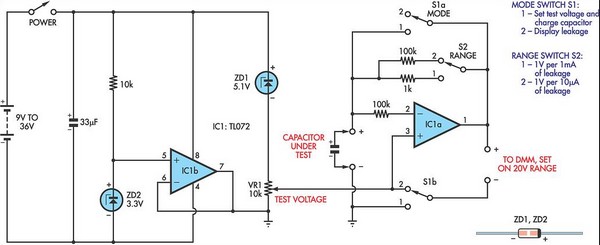Home » Circuits
Capacitor Leakage Adaptor For DMMs
Used with a DMM on the 20V range, this circuit gives a rapid and direct measure of the leakage current of capacitors. There are two ranges, with maximum readings of about 20µA and 2mA, and the test voltage can be varied. This lets you test leakage at or near the capacitor's rated voltage. In addition, the circuit can help determine the amount of internal electro-chemical activity, which reduces the capacitor's lifespan. For example, one 0.33F 5.5V super capacitor I tested has an open-circuit voltage that rises exponentially to about 0.8V over a period of 10 days.Note:
Super capacitors are technically called electro-chemical capacitors but they store energy electrostatically like other capacitors. To quantify the internal electro-chemical activity of a capacitor using this circuit, simply measure the capacitor's "leakage" with the test voltage set to zero. If the reading is negative, the capacitor is self-charging with its plus terminal becoming positive with respect to its minus terminal. If the reading is greater than zero, the capacitor is self-charging with its minus terminal becoming positive with respect to its plus terminal. In the circuit, the 10kO potentiometer (VR1) adjusts the test voltage.
Zener diode ZD1 limits the maximum test voltage to ensure that the output of IC1a can swing to at least 2V above the test voltage. IC1b and associated components derive the ground rail from the single-ended supply. The negative supply voltage is fixed at -3.3V by ZD2 to give more range to the test voltage, which is derived from the positive supply. The circuit will operate from any voltage in the range 9-36V but keep in mind that the maximum test voltage is 8.4V less than the supply voltage. With S1 in position 1, IC1a is configured as a unity gain buffer and the DMM reads its output voltage.
Circuit diagram:
Without a test capacitor (CUT) connected, the DMM will display the test voltage. When a CUT is connected, it will be rapidly charged to the test voltage via S1a. The 100kO resistor in series with the inverting input to IC1a protects the op amp in case a capacitor charged to a high voltage is connected to the test terminals, particularly when power to the circuit is off. However, it offers no protection against a charged capacitor being connected to the test terminals in reverse. Position 2 of S1a configures the circuit to display the leakage of the capacitor. The feedback resistor around IC1a is set to 100kO or 1kO by switch S2, while S1b connects the DMM to show the difference between the test voltage and the output of IC1a.
In this position, IC1a maintains the test voltage across the CUT. Since no current flows into the op amp input, any leakage current flowing through the CUT must also flow through the selected feedback resistor (R). IC1a will therefore raise its output voltage above the test voltage by I x R volts, and this difference will be shown on the DMM. To use the circuit, first set S2 to the desired range, then place S1 into position 1 and adjust the 10kO pot until the desired test voltage is shown on the DMM. That done, connect the capacitor to be tested and wait for the DMM reading to stabilize at the test voltage. Now switch S1 to position 2, whereupon the DMM will show the leakage of the capacitor.
Author: Andrew Partridge - Copyright: Silicon Chip Electronics

